Increased cAMP in monocytes augments Notch signaling mechanisms by elevating RBP-J and transducin-like enhancer of Split (TLE).
Larabee, JL; Shakir, SM; Barua, S; Ballard, JD
The Journal of biological chemistry
288
21526-36
2013
Show Abstract
In cells of the innate immune system, pathological increases in intracellular cAMP attenuate immune responses and contribute to infections by bacteria such as Bacillus anthracis. In this work, cAMP from B. anthracis edema toxin (ET) is found to activate the Notch signaling pathway in both mouse macrophages and human monocytes. ET as well as a cell-permeable activator of PKA induce Notch target genes (HES1, HEY1, IL2RA, and IL7R) and are able to significantly enhance the induction of these Notch target genes by a Toll-like receptor ligand. Elevated cAMP also resulted in increased levels of Groucho/transducin-like enhancer of Split (TLE) and led to increased amounts of a transcriptional repressor complex consisting of TLE and the Notch target Hes1. To address the mechanism used by ET to activate Notch signaling, components of Notch signaling were examined, and results revealed that ET increased levels of recombinant recognition sequence binding protein at the Jκ site (RBP-J), a DNA binding protein and principal transcriptional regulator of Notch signaling. Overexpression studies indicated that RBP-J was sufficient to activate Notch signaling and potentiate LPS-induced Notch signaling. Further examination of the mechanism used by ET to activate Notch signaling revealed that C/EBP β, a transcription factor activated by cAMP, helped activate Notch signaling and up-regulated RBP-J. These studies demonstrate that cAMP activates Notch signaling and increases the expression of TLE, which could be an important mechanism utilized by cAMP to suppress immune responses. | Western Blotting | 23775085
 |
MAML1 regulates cell viability via the NF-κB pathway in cervical cancer cell lines.
Yanin Kuncharin,Naunpun Sangphech,Patipark Kueanjinda,Parvapan Bhattarakosol,Tanapat Palaga
Experimental cell research
317
2011
Show Abstract
The Notch signaling pathway plays important roles in tumorigenesis in a context-dependent manner. In human cervical cancer, alterations in Notch signaling have been reported, and both tumor-suppressing and tumor-promoting roles of Notch signaling have been proposed; however, the precise molecular mechanisms governing these roles in cervical cancer remain controversial. MAML is a transcriptional co-activator originally identified by its role in Notch signaling. Recent evidence suggests that it also plays a role in other signaling pathways, such as the p53 and β-catenin pathways. MAML is required for stable formation of Notch transcriptional complexes at the promoters of Notch target genes. Chromosomal translocations affecting MAML have been shown to promote tumorigenesis. In this study, we used a truncated dominant-negative MAML1 (DN-MAML) to investigate the role of MAML in HPV-positive cervical cancer cell lines. Three human cervical cancer cell lines (HeLa, SiHa and CaSki) expressed all Notch receptors and the Notch target genes Hes1 and MAML1. Among these 3 cell lines, constitutive appearance of cleaved Notch1 was found only in CaSki cells, which suggests that Notch1 is constitutively activated in this cell line. Gamma secretase inhibitor (GSI) treatment, which suppresses Notch receptor activation, completely abrogated this form of Notch1 but had no effect on cell viability. Overexpression of DN-MAML by retroviral transduction in CaSki cells resulted in significant decreases in the mRNA levels of Hes1 and Notch1 but had no effects on the levels of MAML1, p53 or HPV E6/E7. DN-MAML expression induced increased viability of CaSki cells without any effect on cell cycle progression or cell proliferation. In addition, clonogenic assay experiments revealed that overexpression of DN-MAML resulted in increased colony formation compared to the overexpression of the control vector. When the status of the NF-κB pathway was investigated, CaSki cells overexpressing DN-MAML exhibited loss of phospho-IκBα, decreased total IκBα and nuclear localization of NF-κB p65, which suggests that the NF-κB pathway is hyperactivated. Furthermore, increased level of cleaved Notch1 was detected when DN-MAML was expressed. When DN-MAML-overexpressing cells were treated with GSI, significantly decreased cell viability was observed, indicating that inhibition of Notch signaling using GSI treatment and DN-MAML expression negatively affects cell viability. Taken together, targeting Notch signaling using DN-MAML and GSI treatment may present a novel method to control cell viability in cervical cancer cells. | | 21640102
 |










